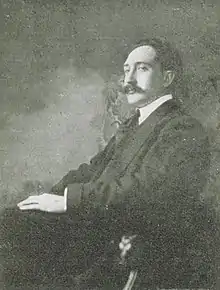Gabriel Grovlez
Gabriel Marie Grovlez (4 April 1879 – 20 October 1944) was a French composer, conductor, pianist, and music critic.

Life
Born in Lille, Grovlez studied with Gabriel Fauré, Louis Diémer, and André Gedalge at the Conservatoire de Paris. At the Schola Cantorum, Charles Bordes introduced him to Gregorian Chant and the music of the Renaissance.[1]
As a solo pianist and accompanist Grovlez toured through Europe. He was professor of piano at the Schola Cantorum from 1899 to 1909, choir director and deputy conductor of the Opéra Comique (1905–1908), and musical director at the Théâtre des Arts (1911–1913) where he was responsible for the first performances of Albert Roussel's Le Festin de l'araignée, Maurice Ravel's Ma mère l'oye, and a number of baroque operas.
From 1914, he was for twenty years the director of the Opéra de Paris ("Societé Nationale de l'Opéra"), where, among other productions, he also conducted a season of Diaghilev's Ballets Russes. As a guest conductor he worked at opera houses in Monte Carlo, Cairo, Lisbon, New York, and Chicago.
As a composer, his compositions were mainly for voice and for the stage, including ballets. Much of his work shows strong neo-classical influences. He also wrote reviews for Paris music journals including Excelsior (1916–17) and L'Art musical (1937–39).
Grovlez died aged 65 in Paris.
Selected works
- Stage
- Cœur de rubis, Légende féérique (opera) in 3 acts (1906), libretto by Gabriel Montoya
- Maïmouna, fantasy-ballet in 2 scenes (1916), libretto by P. André Gérard
- La Vrai arbre de Robinson, ballet in 1 act (1921)
- Le Marquis de Carabas, "conte lyrique" in 3 acts (1926), libretto by R. Coolus
- La Princesse au jardin, ballet in 1 act (1943), libretto by Émile Vuillermoz
- Orchestra
- Dans le jardin (1907), tone poem for soprano, female choir and orchestra
- La Vengeance des fleurs (1910)
- Le Reposoir des amants (1914)
- Chamber music
- Sonata for violin and piano (1908)
- Divertissement for flute and piano (1912)
- Concertino for flute or clarinet and piano
- Lamento et tarentelle for clarinet and piano (1923)
- Romance et scherzo for flute and piano (1927)
- Sarabande et allegro for oboe and piano (1929)
- Sicilienne et allegro giocoso for bassoon and piano (1930)
- Romance, scherzo et finale for viola and piano (1932)
- Sonata for cello and piano (1936)
- Romance et scherzo for flute and viola
- Piano
- Au jardin de l'enfance, 6 pieces after L'Art d'être grand-père by Victor Hugo (1907). Contains: La Sieste; Chose du soir; Chanson de grand-père; Chanson d'ancêtre; Chanson pour faire danser en rond les petits enfants; Pepita.
- 3 Improvisations sur Londres (3 Impressions of London) (1910). Contains: ''Westminster Abbey; The Park; Soir de dimanche sur les bords de la Tamise
- L'Almanach aux images, 8 Pieces after poems of Tristan Klingsor (1911). Contains: Les Marionnettes; Berceuse de la poupée; La Sarabande; Chanson du chasseur; Les Ånes; Le Pastour; Chanson de l'escarpolette; Petites litanies de Jésus.
- Trois Pièces (1913). Contains: Évocation; Barcarolle; Scherzo
- Fancies (1915). Contains: Sérénade; Nocturne; Petite valse; Berceuse; Fileuse; Rêverie; Cake Walk.
- Trois Valses romantiques (1917)
- Deux Études de difficulté transcendante (1919)
- Impressions, 2 pieces (1934)
- Vocal
- La Chambre blanche, 10 Songs on poems of Henry Bataille (1903)
- La Flûte for voice and piano (1907); words by José-Maria de Heredia
- Sagesse, 5 Poems of Paul Verlaine for high voice and piano (1910)
- Trois Mélodies sur des poèmes de Jean Dominique for voice and piano (1912)
- Guitares et mandolines for voice and piano (1913); words by Camille Saint-Saëns
- Les Mélancolies passionnées, 8 Songs on poems of Charles Guérin (1924)
- Trois Ballades françaises for voice and piano on poems of Paul Fort (1927)
References
- Guy Ferchault, "Grovlez, Gabriel (Marie)", in: Die Musik in Geschichte und Gegenwart (MGG), rev. ed., biographical part vol. 8 (Kassel: Bärenreiter, 2002), cc. 106.